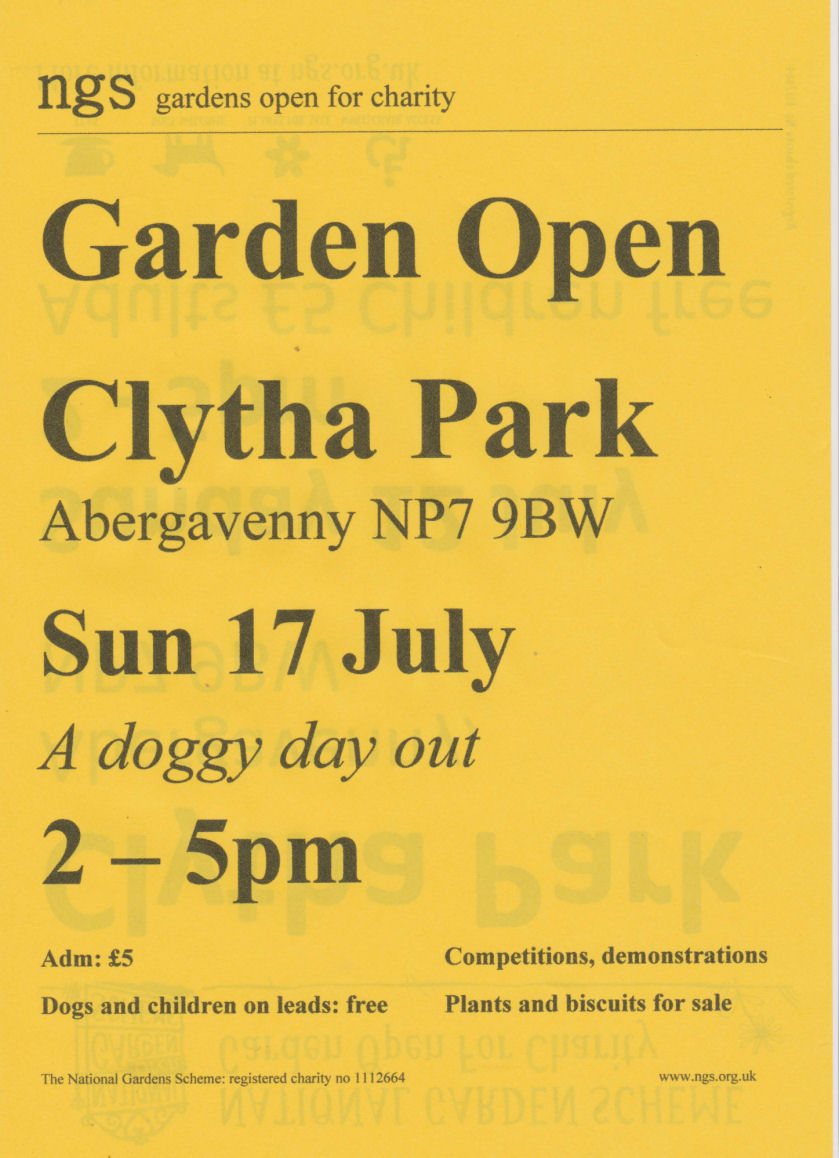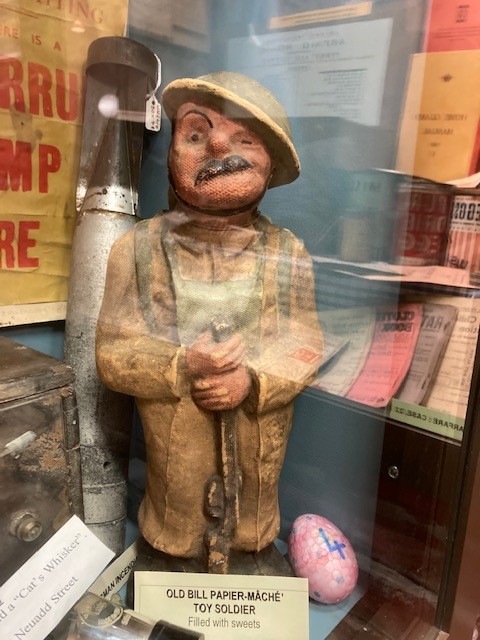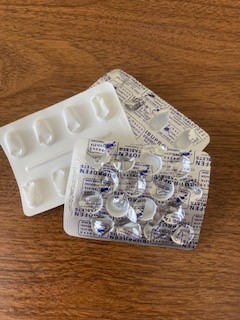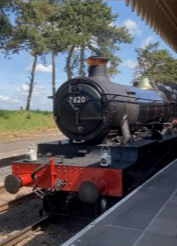Dates for your Diary
Clytha Park Open day – Sunday 17th July 2-5pm
Abergavenny NP7 9BW – Admission £5 (dogs & children on leads free entry!)
Museum opening times
The Museum is open to the public, free of charge:
Thursday* to Saturday 10am – 1pm
June 100 Club
This month’s prize numbers were drawn by member Margaret Dyer and the winners are:-
No. 88 Matthew Price £20
No. 11 Liz Ewers £10
If you would like to join our 100 club and be in with a chance of winning, it costs just £1 a month. Ask at the museum for further details.
Car Treasure Hunt
Given the current extortionate price of fuel this may not be the best of times to try this however it is great fun so, if you would be interested in taking part in a Car Treasure Hunt please email your expression of interest. If enough interest, there would be a small nominal entry fee per car and a prize for the winners!
Clytha Park Garden Open Day

As part of the ‘National Garden Scheme’, which supports charities through admissions, teas and cakes, the garden at the home of our President Mr Jack Hanbury, is once again open to the public on Sunday 17th July 2-5pm.
Entry costs £5 for adults (children and dogs free!) and can be paid on the day.
Old Bill
 All our volunteers have their favourite exhibits and this is my hubby’s. Made of paper maché, ‘Old Bill’ is from the 1920s and is hollow with a hole at the base. He would have been filled with sweets and given to children at Christmas. As for his name, that came as a result of a cartoon character created in 1914 by cartoonist Bruce Bairnsfather. You’ll find Old Bill in the Warfare case next to the air raid shelter. Pay him a visit next time you’re at the museum.
All our volunteers have their favourite exhibits and this is my hubby’s. Made of paper maché, ‘Old Bill’ is from the 1920s and is hollow with a hole at the base. He would have been filled with sweets and given to children at Christmas. As for his name, that came as a result of a cartoon character created in 1914 by cartoonist Bruce Bairnsfather. You’ll find Old Bill in the Warfare case next to the air raid shelter. Pay him a visit next time you’re at the museum.
 Blister Packs
Blister Packs
Rather than throw away your empty blister packs now you can recycle them! Simply take them along to any Superdrug store that has a pharmacy and drop them in the box provided.
The Curse of Littlecote House

Hungerford is probably most known for the notorious Michael Ryan who, on 19th August 1987, shot 31 people killing 16 of them but it is also the home of Littlecote House. I first visited the house in the late 1980s. Back then the house hosted country fayres with falconry displays, crafts and jousting displays and one such event was taking place the week of the massacre. Indeed it was just one day earlier, 18th August 1987, that yours truly had driven through Hungerford to said event at Littlecote House! The house, said to the third most haunted in Britain, was built in the 13th century and was the home of the De Calstone family. In 1415 Elizabeth De Calstone married one William Darrell and the house then became home to the Darrells. The house is steeped in history and it was at this house that King Henry VIII met and courted his third wife, Jane Seymour, who was the granddaughter of Elizabeth Darrell. This story concerns the last of the Darrells, ‘Wild’ William Darrell…
One night in 1575 a midwife known as Mother Barnes and who lived at Great Shefford, seven miles from Hungerford, had a visit from some men. They told her she was needed to deliver a baby and she would be well rewarded for her service provided she agreed never to tell a soul. She agreed and was taken, blindfolded, in a carriage to Littlecote House. In a first floor bedroom was a woman, her face veiled, and she was in labour. A man, presumed to be the father and later identified as William Darrell, commanded her to deliver the child and save the life of the woman. Mother Barnes did as she was asked and presented the newborn baby boy to Darrell who was warming himself by the fire. Rather than embrace his son, he then instructed her to throw the child in the fire. Horrified, Mother Barnes pleaded for the boy’s life, even offering to keep the child herself and raise him as her own however she was thrown aside, the child snatched from her arms and hurled into the fire where it perished.
For many years Mother Barnes kept the secret but, when she knew she was dying, records exist that show she told all to a local magistrate and although she never directly named Littlecote House or William Darrell in her statement, the finger of blame quickly pointed at him and in 1586 Darrell was charged with murder. His trial date was set but the trial never took place and Darrell fled to London. The Attorney General, Sir John Popham, who was also Darrell’s cousin (and the same John Popham who would later sentence Guy Fawkes to death) then became the new owner of Littlecote House amid speculation of bribery! Darrell returned to Hungerford for a visit in late 1589 but the horse he was riding was spooked and he was thrown to the ground and died.

Mother Barnes, Darrell and the baby
It is said his horse was startled by an apparition of a child rising from flames and while Darrell lay on the ground dying he is said to have placed a curse on Littlecote House that no male-born son would ever live long enough to inherit the house and none ever have with the shrine to one infant still available to see in the house today.
There were many theories as to the identity of the woman who had given birth that night with the favourite being that it was Anne Hungerford, wife of Sir Walter Hungerford who in 1568, had accused Darrell of having an affair with his wife and of fathering a child by her but this is pure speculation. Whoever she was though, she is said to now wander the halls of Littlecote House, weeping and searching for her child. The sound of a baby crying is also said to haunt the house.
In 1996 the house was bought by Warner Leisure Hotels who built a new modern hotel alongside the house though guests can also stay in the historic house itself. Much of the house remains as it was and a free audio tour is available to Warner Hotel guests. Always wanting to stay in a ‘haunted house’, hubby and I ticked this off our ‘bucket list’ in 2014 with a stay in one of the historic rooms at Littlecote House. We didn’t encounter any ghosts but there was one incident we couldn’t explain when a lipstick stain (not mine) on a glass vanished mysteriously even though no-one had entered our room…! If you’re feeling brave you can book here.
And you can see more photos of Littlecote on our Facebook page. Sally Murphy
Gloucester Warwickshire Steam Railway
 Modern trains get you from A to B quickly, smoothly and efficiently, but there’s nothing quite like a trip on a good old fashioned Steam Train! There are many ‘heritage’ railways around the country and one such railway is the Gloucester Warwickshire Railway which runs from Cheltenham Race Course and terminates at Broadway Station in the Cotswolds.
Modern trains get you from A to B quickly, smoothly and efficiently, but there’s nothing quite like a trip on a good old fashioned Steam Train! There are many ‘heritage’ railways around the country and one such railway is the Gloucester Warwickshire Railway which runs from Cheltenham Race Course and terminates at Broadway Station in the Cotswolds.
The railway was built in the early 1900s as part of the Great Western Railway’s route from central England to the South West with the first train running between Wolverhampton and the West country in 1910. In 1948 the railways were nationalised and it became part of British Rail. The line continued to operate until 1976 when disaster struck. A train was derailed at Winchcombe and the line closed. In 1979 the track was lifted and many buildings were demolished.
This prompted local people and rail enthusiasts alike to try and save the line. They initially bought 15 miles of track and the remaining buildings before being granted a Light Rail Order which allowed them to rebuild the line between Broadway and Cheltenham. Over the last four decades a small army of volunteers, including engineers, mechanics, carpenters, upholsterers, painters, bricklayers and caterers have worked tirelessly to restore the line, build stations and other infrastructure with the final section of track to Broadway opening in 2018.
Today the railway operates with a handful of paid staff and nearly 1000 volunteers and has responsibility for 46 bridges, a viaduct, two tunnels and 30 miles of fencing and drainage channels. In comparison it makes running our small museum look like a piece of cake!
Hubby and I took a ride on the railway recently, boarding at Cheltenham Race Course and disembarking at Broadway. With us in our carriage was our very knowledgeable guide, Dave, who gave us a fascinating and detailed commentary throughout our 14 mile / 45 minute trip while we enjoyed refreshments from the buffet car.
Our trip took us through Gotherington followed by the 693 yard Greet Tunnel (which is said to be haunted) before arriving at Winchcombe Station. Alight at Winchcombe and you can enjoy refreshments in the 1950s themed ‘Coffee Pot Café’ run entirely by volunteers. Here too you can visit the Model Railway Coach which is housed in a former Royal Mail carriage and you can even listen to stories about the railway in their ‘Dial-A – Story’ telephone kiosk!

Picturesque Gotherington Signal Box
Next stop is Hayles Abbey Halt. Alight here to visit the near-by Hailes Abbey Museum or stay aboard to journey on to Toddington with its Railway Shop, ‘Flag and Whistle’ Tea Room and the Toddington Narrow Gauge Railway and with a ‘Day Rover’ Ticket you can hop on and off all day long.
As well as steam trains, the railway also has a number of diesel trains, all of which are over 50 years old and depending on the day of your visit, you may get to ride on one of those.
For more information, or to book tickets, telephone 01242 621405 or use this link
Sally Murphy
SHEEP

I saw this bedraggled specimen a couple of weeks ago while walking over Mynydd Llanhilleth. It was a hot day and she clearly didn't intend to hang around waiting for the shearing team to turn up. At least she was clean, if a bit scruffy. When I was growing up in Abertillery in the fifties there were sheep everywhere – walking on the roads, on any spare scrap of land and certainly in your garden if you happened to leave the gate open. This was when mining was in its heyday, coal waste was tipped here, there and everywhere and environmental protection was almost unheard of. As a consequence there was a lot of coal dust in the air and that landed on the sheep. Apart from the first few days of their lives the sheep in Abertillery were invariably grey in colour and a far cry from the fluffy white bundles portrayed in children's story books.
Changed farming practices mean fewer sheep these days although I still occasionally see a few sheep wandering along the road when I drive to Abertillery, and I usually encounter them when out walking. I am a member of a walking club and we invariably carry out a few sheep rescues through the year. In fact, as I write this I can tell you that we rescued a young sheep only last week – it had poked its head through the fence to nibble some enticing looking grass but as it had horns, albeit short ones, it couldn't get his head back through the hole. It took quite a bit of effort to free it. Dopey or not, I still have a bit of a soft spot for sheep. Can I say that in the same breath as admitting that sweet Welsh lamb is my favourite meat?!!
When you travel around the country you realise just how many different breeds of sheep there are. The Welsh Hill sheep aren't the prettiest but, although small, they are definitely amongst the noisiest. Sheep may be common but it is easy to forget just how big a role they have played in the British economy until, that is, you visit the Cotswolds (where sheep were first introduced by the Romans) and see all the magnificent parish churches which were built in the fifteenth century on the back of the fortunes made from wool. How different today when the fleeces are worth so little that the farmers suffer a loss shearing their sheep. Efforts are being made to find new uses for British wool other than in carpets, and insulation is one area where sheep's wool is increasingly being used but not yet on a large enough scale. A friend of mine has her cat food delivered by post and the insulation used in transit is some sort of processed sheep wool. Some of that gets further recycled in our compost heap. It looks as if the farmer who owns the sheep in this photograph won't have to pay for it to be sheared; it is self-shearing!
Still on the subject of lamb, here is one of my favourite lamb recipes:
Lamb Provencal (serves 4)
- 1.5lb cubed lamb
- salt and pepper
- 2oz butter
- 2 tablespoons oil
- 2 chopped onions
- 1 diced pepper
- 4oz sliced mushrooms
- 1 teaspoon paprika
- 1 crushed garlic clove
- 1 small chilli pepper (optional)!
- 12oz tin tomatoes
- 1 tablespoon tomato puree
- 1 teaspoon mixed herbs and a bay leaf
- 1/2 pint wine or stock
Method
- Season the lamb and fry it in the oil and butter to brown.
- Remove the meat and add the other vegetables and fry lightly, adding in the spices.
- Add the herbs, meat, tomatoes, puree and wine/stock and bring to the boil.
- Cook covered for 2 hours or so in the oven at 170ºC, 150ºC fan.
- Serve with whatever takes your fancy!
Jen Price
Top Of Page
